ESP MERCEDES-BENZ CLA COUPE 2019 User Guide
[x] Cancel search | Manufacturer: MERCEDES-BENZ, Model Year: 2019, Model line: CLA COUPE, Model: MERCEDES-BENZ CLA COUPE 2019Pages: 330, PDF Size: 52.4 MB
Page 35 of 330
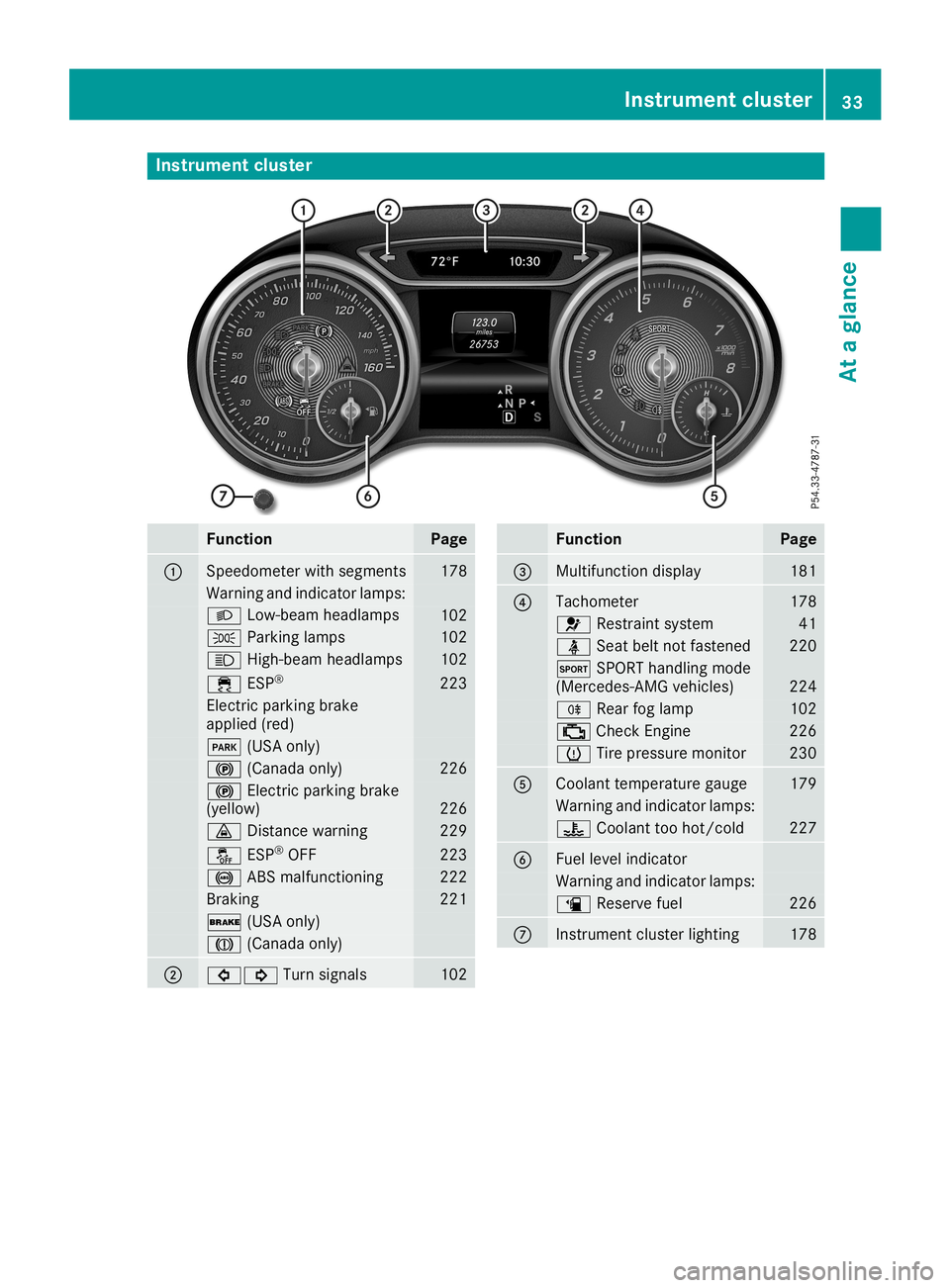
Inst
rumen tclus ter Funct
ion Pag
e 0043
Sp
eedo meterwit hseg men ts 17
8 Warn
ingand indicat orlamp s: 0058
Low-beam headlamps 10
2 0060
Parkinglamp s 10
2 0057
High-beam headlamps 10
2 00E5
ESP® 22
3 El
ec tric park ingbrak e
applie d(re d) 0049
(USAon ly) 0024
(Canadaonly) 22
6 0024
Elec tric park ingbrak e
(yello w) 22
6 00BA
Distanc ewarn ing 22
9 00BB
ESP®
OF F 22
3 0025
ABSmalf unction ing 22
2 Br
aki ng 22
1 0027
(USAon ly) 004D
(Canadaonly) 0044
003E003D
Turnsignals 10
2 Funct
ion Pag
e 0087
Mult
ifunction disp lay 18
1 0085
Tac
hom eter 17
8 0075
Restraintsyst em 41
00E9
Seat belt notfas tene d 22
0 0074
SPORT handlingmod e
(Mer cedes- AMGveh icles) 22
4 005E
Rearfoglamp 10
2 00B9
CheckEn gin e 22
6 0077
Tirepre ssur emon itor 23
0 0083
Coolan
tte mpe rature gauge 17
9 Warn
ingand indicat orlamp s: 00AC
Coolan tto ohot /cold 22
7 0084
Fue
llev elind icat or Warn
ingand indicat orlamp s: 00D4
Reservefuel 22
6 006B
In
st rum entclus terligh ting 17
8 Inst
rume ntclust er
33Ataglan ce
Page 37 of 330
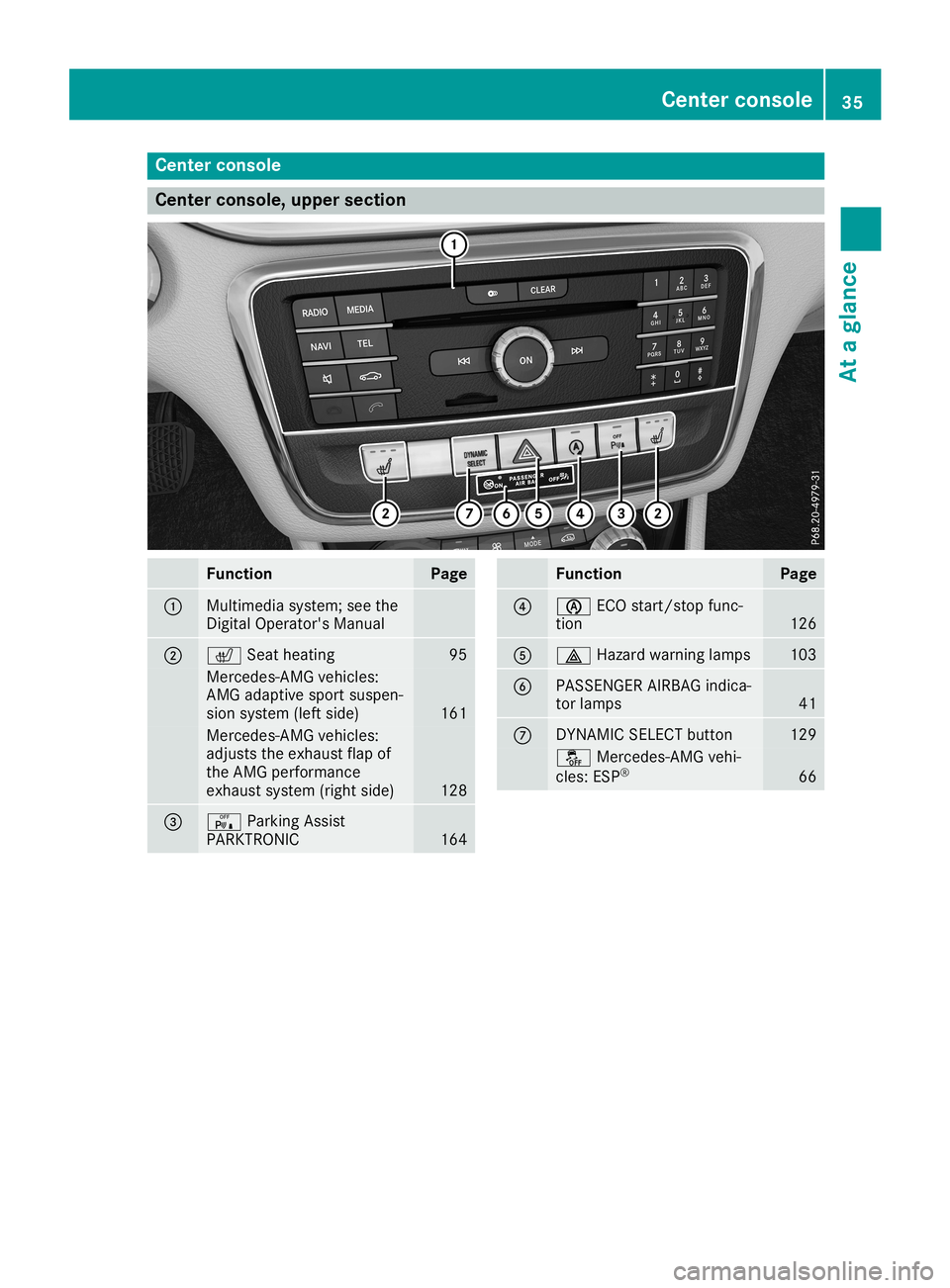
Cent
erconsole Cent
erconsole, upper sect ion Funct
ion Pag
e 0043
Mult
imed iasyst em; seethe
Dig ital Oper ator'sMan ual 0044
0072
Seatheating 95
Mer
cedes-AM Gveh icles:
AM Gadapt ivespor tsuspe n-
sion system(leftside) 16
1 Mer
cedes-AM Gveh icles:
adj ust sth eex haust flapof
th eAM Gperf ormance
ex haust system(rightside) 12
8 0087
008F
ParkingAssist
PA RKTRO NIC 16
4 Funct
ion Pag
e 0085
00D6
ECOstart /stopfun c-
tio n 12
6 0083
002F
Hazard warn inglamps 10
3 0084
PA
SS EN GER AIRBA Gind ica-
to rlamps 41
006B
DYN
AMICSELECT but ton 12
9 00BB
Mercedes-AM Gveh i-
cle s:ES P® 66Cent
erconsole
35Ataglan ce
Page 48 of 330
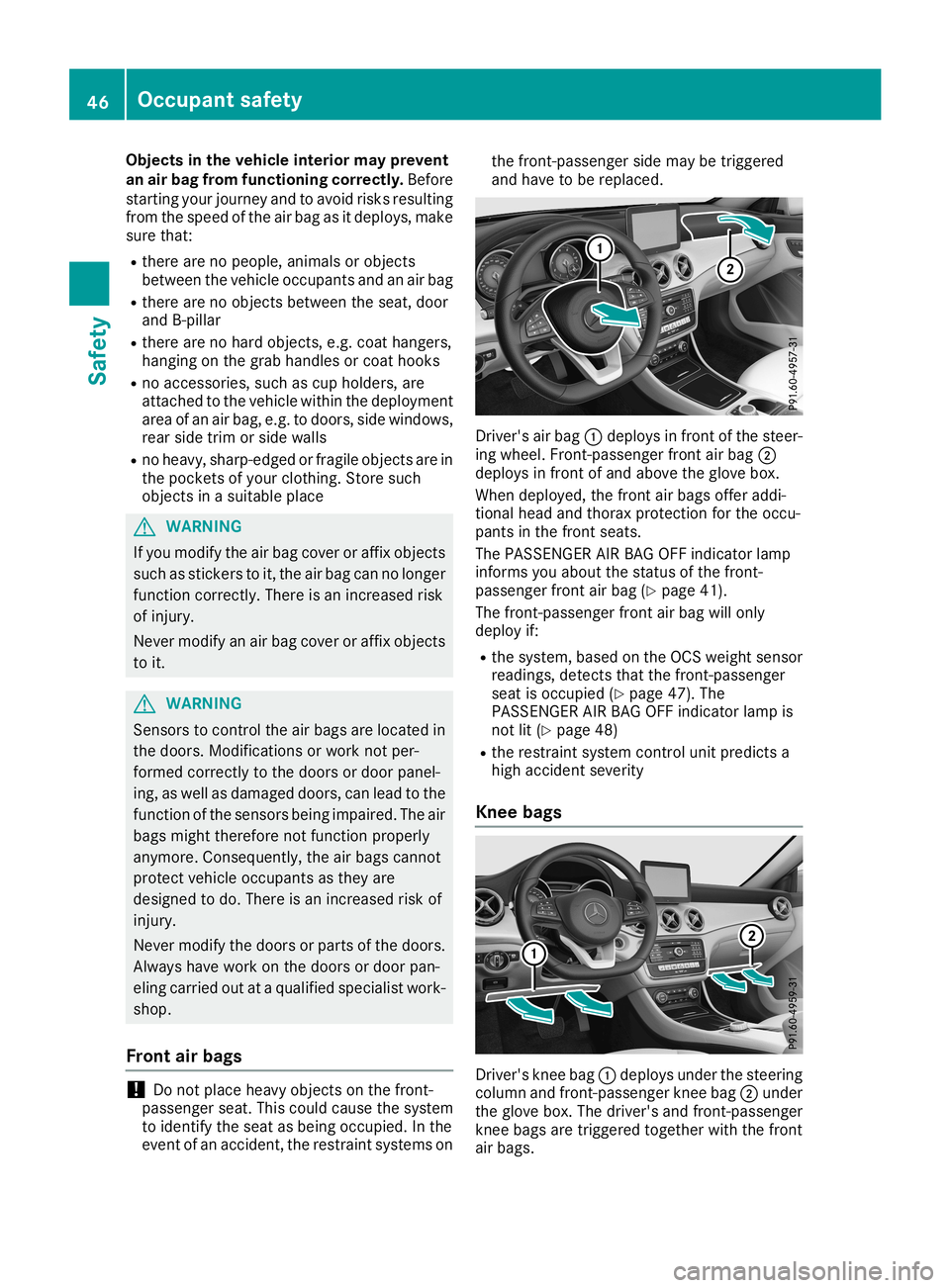
Objects
inthe vehicle interior mayprevent
an air bag from functioning correctly.Before
start ingyour journ eyand toavoid risksresulting
from thespeed ofthe airbag asitdeploys, make
sure that:
R there arenopeople, animals orobject s
between thevehicle occupant sand anair bag
R there arenoobject sbetween theseat, door
and B-pillar
R there arenohard object s,e.g. coat hangers,
hanging onthe grab handles orcoat hooks
R no accessor ies,such ascup holders, are
attac hedtothe vehicle withinthedeployment
area ofan air bag, e.g.todoors, sidewindows,
rear side trimorside walls
R no heavy, sharp-edged orfragile objectsare in
the pocket sof your clothing.Store such
object sin asuitable place G
WARNIN
G
If you modify theairbag cover oraffix object s
such asstick erstoit,the airbag cannolonger
funct ioncorr ectly. There isan incr eased risk
of injury.
Never modify anair bag cover oraffix object s
to it. G
WARNIN
G
Sens orstocont rolthe airbags arelocated in
the doors. Modification sor work notper-
formed correctly tothe doors ordoor panel-
ing, aswell asdamaged doors,canlead tothe
funct ionofthe sensor sbeing impaired. Theair
bags might thereforenot funct ionproperly
anymore. Consequent ly,the airbags cannot
protec tvehicle occupant sas they are
designed todo. There isan incr eased riskof
injury.
Never modify thedoors orparts ofthe doors.
Always havework onthe doors ordoor pan-
eling carried outataqualified specialist work-
shop.
Front airbags !
Do
not place heavy objectson the fron t-
passenger seat.Thiscould cause thesystem
to identif ythe seat asbeing occupied. Inthe
event ofan accident ,the restr aintsystems onthe
fron t-passenger sidemay betrigger ed
and have tobe replaced. Driver
'sair bag 0043deploys infron tof the steer-
ing wheel. Front-passenger frontair bag 0044
deploys infron tof and above theglove box.
When deployed, thefron tair bags offeraddi-
tional headandthorax protectionforthe occu-
pants inthe fron tseats.
The PASSENGER AIRBAG OFFindicato rlamp
inform syou about thestatusofthe fron t-
passenger frontair bag (Ypage 41).
The front-passenger frontair bag willonly
deploy if:
R the system, basedonthe OCS weight sensor
readings, detectsthat thefron t-passenger
seat isoccupied (Ypage 47).The
PAS SENGER AIRBAG OFFindicato rlamp is
not lit(Y page 48)
R the restr aintsystem controlunit predict sa
high accident severity
Knee bags Driver
'skn ee bag 0043deploys underthesteerin g
column andfront-passenger knee bag 0044under
the glove box.Thedriver's andfront-passenger
kn ee bags aretrigger edtoget herwith thefron t
air bags. 46
Occupant
safetySafety
Page 49 of 330
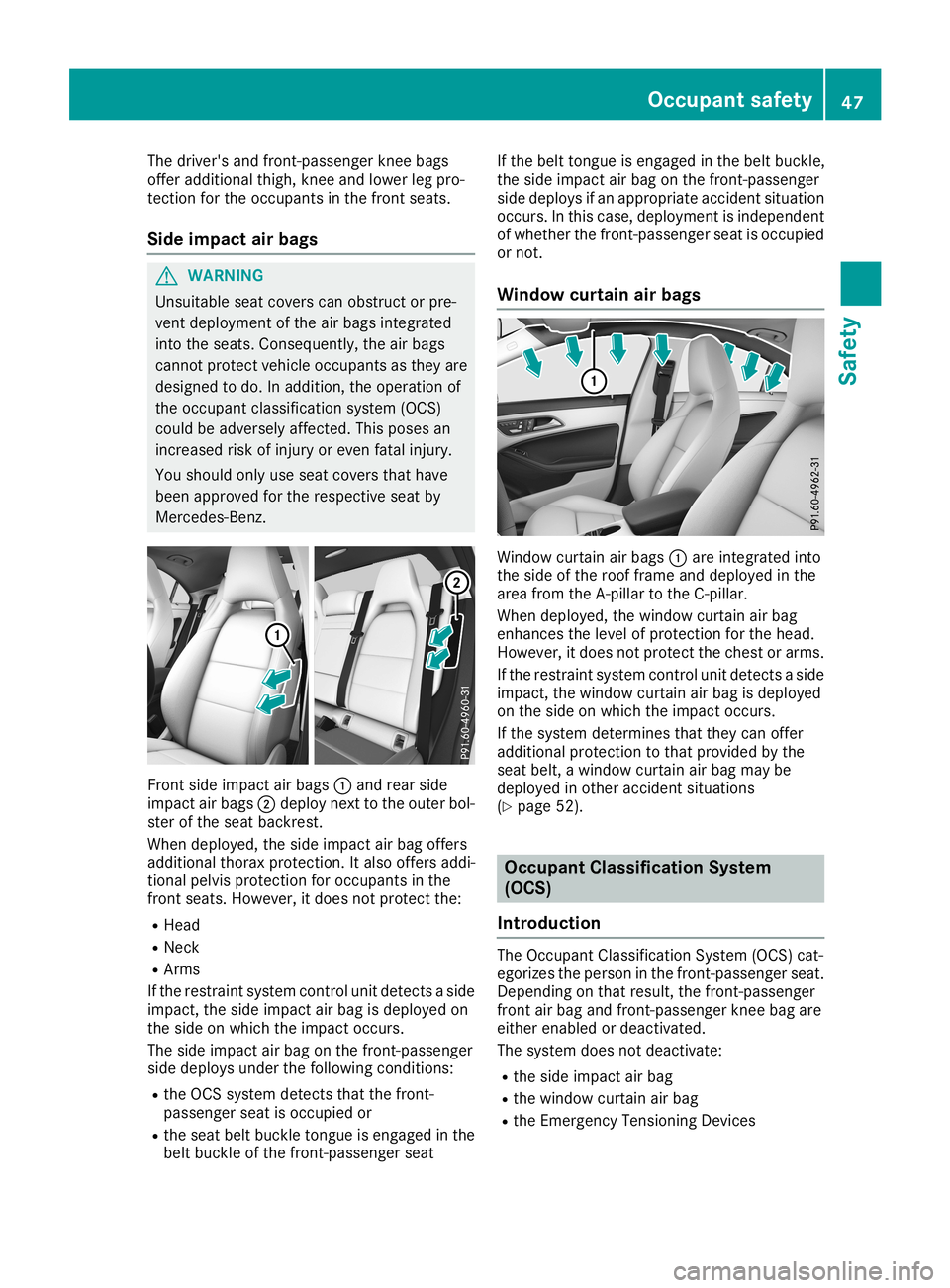
The
driver's andfront -passenger kneebags
offer additional thigh,kneeandlower legpro-
tect ionforthe occupant sin the front seats.
Side impa ctair bags G
WARNIN
G
Unsuitable seatcovers canobstruct orpre-
vent deployment ofthe airbags integr ated
into theseats. Consequently, theairbags
cann otprotec tvehicle occupant sas they are
designed todo. Inaddition, theoperation of
the occupant classification system(OCS)
could beadversely affected.This poses an
increased riskofinjury oreven fatalinjury.
You should onlyuseseat covers thathave
been approved forthe respect iveseat by
Mercedes- Benz. Fron
tside impact airbags 0043and rear side
impact airbags 0044deploy nexttothe outer bol-
ster ofthe seat backrest .
When deployed, theside impact airbag offers
additional thoraxprotection.Italso offers addi-
tional pelvis protec tionforoccupant sin the
front seats. However, itdoes notprotec tthe:
R Head
R Neck
R Arms
If the restr aintsystem controlunit detect sa side
impact, theside impact airbag isdeployed on
the side onwhich theimpact occurs.
The side impact airbag onthe front -passenger
side deploys underthefollowing conditions:
R the OCS system detectsthat thefront -
passenger seatisoccupied or
R the seat beltbuckle tongue isengaged inthe
belt buckle ofthe front -passenger seat If
the belt tongue isengaged inthe belt buckle,
the side impact airbag onthe front -passenger
side deploys ifan appropriate accidentsituation
occurs. Inthis case, deployment isindependent
of whether thefront -passenger seatisoccupied
or not .
Window curtainairbags Window
curtainairbags 0043are integr atedinto
the side ofthe roof frame anddeployed inthe
area from theA-pillar tothe C-pillar.
When deployed, thewindow curtainairbag
enhanc esthe level ofprotec tionforthe head.
However, itdoes notprotec tthe chest orarms.
If the restr aintsystem controlunit detect sa side
impact, thewindow curtainairbag isdeployed
on the side onwhich theimpact occurs.
If the system determin esthat they canoffer
additional protectiontothat provided bythe
seat belt, awindow curtainairbag may be
deployed inother accident situations
(Y page 52). Occupant
Classification System
(OCS)
Introdu ction The
Occupant Classification System(OCS)cat-
egorizes theperson inthe front -passenger seat.
Dependin gon that result, thefront -passenger
front airbag and front -passenger kneebagare
either enabled ordeactivated.
The system doesnotdeactivate:
R the side impact airbag
R the window curtainairbag
R the Emergen cyTensionin gDevices Occupant
safety
47Safety Z
Page 50 of 330
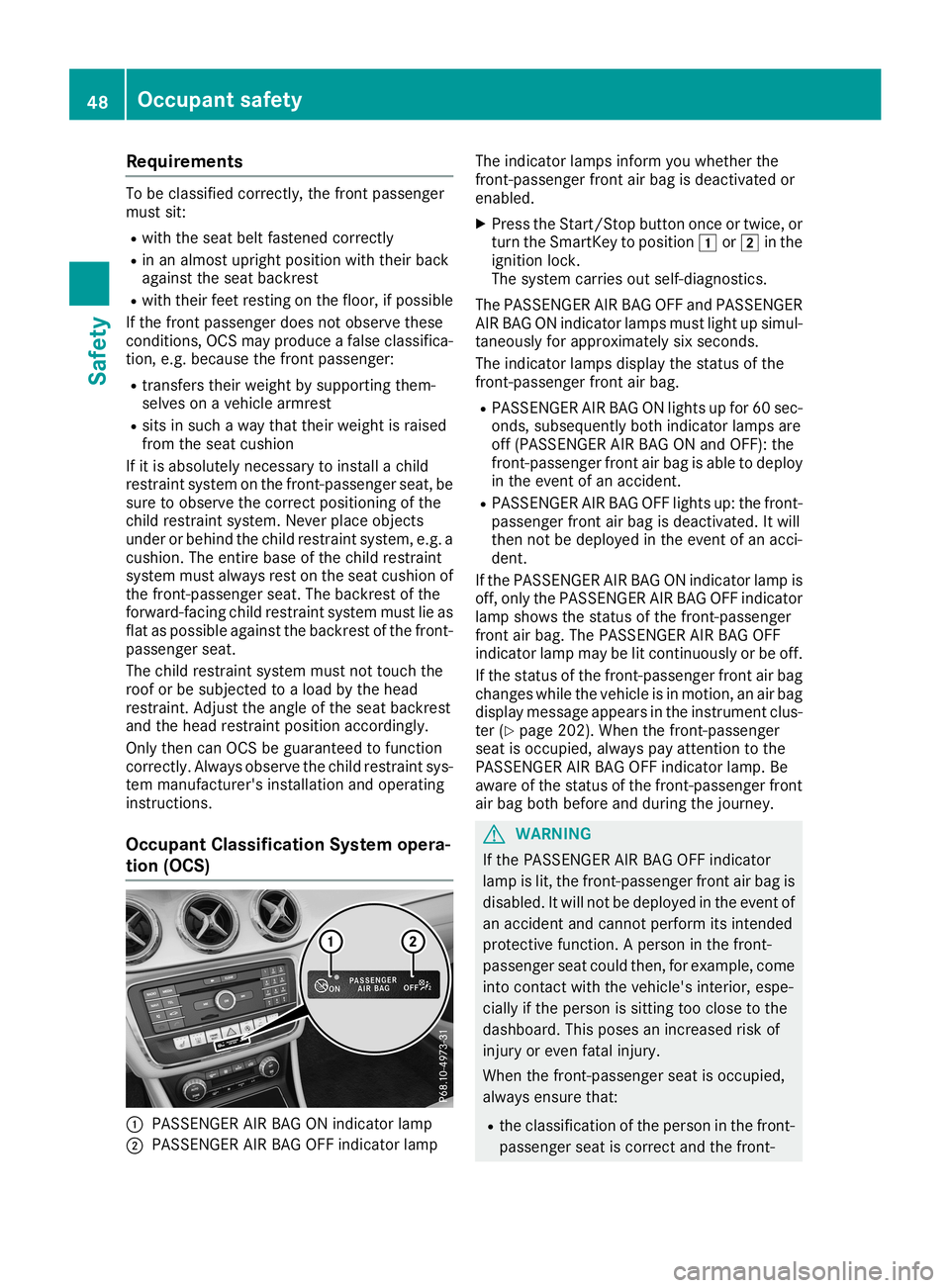
Requi
rements To
be classifiedcorre ctly,the front passe nger
mus tsit:
R with the seatbel tfas tened correctly
R in an almost uprig ht pos ition with thei rba ck
ag ainst the seatba ckrest
R with thei rfee tres ting onthe floor, ifpos sible
If the front passe nger doesnot observe these
condi tions,OC Smay produce afal se cla ssifica -
tion, e.g.because the front passe nger :
R trans ferstheirwe ight by supp orti ngthem-
sel ves onaveh iclearm rest
R sits insuch awa ythat theirwe ight israi sed
from theseatcus hion
If it is ab sol ute lyneces sary to insta lla chi ld
res trai ntsystem onthe front-p asseng ersea t,be
su re to obs erve thecorre ctpos itioning ofthe
chi ldres trai ntsystem. Neverpl ace obje cts
und eror beh indthe childres trai ntsystem, e.g.a
cus hion.The entir eba se ofthe childres trai nt
sy stem mustal wa ysres ton the seatcus hionof
the front-p asseng ersea t.The backrest ofthe
forw ard-faci ngchi ldres trai ntsystem mustlie as
fla tas pos sibleag ainst the backrest ofthe front-
pa sse nger seat.
The childres trai ntsystem mustnot touchthe
roo for be subjecte dto aload bythe head
res trai nt.Adju stthe angleof the seatba ckrest
and theheadres trai ntpos ition acco rdingly .
Only thencanOCSbe guara nteed tofuncti on
corre ctly.Alw aysobs erve thechildres trai ntsys-
tem manu facturer'sinsta llati on and operating
instru ctions .
Oc cupa ntClass ificati onSys tem opera-
tio n(O CS ) 0043
PASSENG ERAIR BAG ONindicator lamp
0044 PASSENG ERAIR BAG OFFindicator lamp The
indicator lamps informyouwh ethe rthe
front-p asseng erfront airba gis dea ctiva tedor
ena bled.
X Pre ssthe Start/Sto pbu tton once ortwi ce, or
turn theSmar tKeytopos ition 0047 or0048 inthe
ig niti onlock.
The system carriesou tsel f-di agnosti cs.
The PASSENG ERAIR BAG OFFandPASSENG ER
AIR BAG ONindicator lamps mustlight upsim ul-
tane ously for appro xima telysixseco nds.
The indicator lamps displ aythe statu sof the
front-p asseng erfront airba g.
R PASSENG ERAIR BAG ONlights upfor 60sec-
onds ,su bse quently bothindicator lamps are
off (PASSEN GERAIRBAG ONand OFF) :the
front-p asseng erfront airba gis ab leto dep loy
in the eventofan acci dent.
R PASSENG ERAIR BAG OFFlights up:the front-
pa sse nger front airba gis dea ctiva ted.Itwi ll
then notbedep loye din the eventofan acci -
dent.
If the PASSENG ERAIR BAG ONindicator lamp is
off, only thePASSENG ERAIR BAG OFFindicator
la mp showsthe statu sof the front-p asseng er
front airba g. The PASSENG ERAIR BAG OFF
ind icator lamp may belit continu ously orbe off.
If the statu sof the front-p asseng erfront airba g
cha nges while the vehicleis in moti on,anairba g
di spl aymes sage appea rsinthe instr umentclu s-
ter (Ypage 202). Whenthe front-p asseng er
sea tis occu pied, alwa yspayattenti ontothe
PASSENG ERAIR BAG OFFindicator lamp. Be
aw are ofthe statu sof the front-p asseng erfront
ai rba gboth before and during thejourney . G
WARNI
NG
If the PASSENG ERAIR BAG OFFindicator
la mp islit, the front-p asseng erfront airba gis
di sa bled. Itwi llnot bedep loye din the eventof
an acci dent andcanno tper form itsintend ed
pro tectiv efuncti on.Aper son inthe front-
pa sse nger seatcou ldthen, forexa mpl e,come
into conta ctwith the vehicle's inter ior, esp e-
cia lly if the person issitti ngtoo closetothe
da shb oard. Thispos esan incre ased riskof
inju ryor eve nfata linju ry.
Whe nthe front-p asseng ersea tis occu pied,
al wa ysensu rethat:
R the classifica tion ofthe person inthe front-
pa sse nger seatis corre ctand thefront- 48
Oc
cupan tsafe tySafe ty
Page 52 of 330
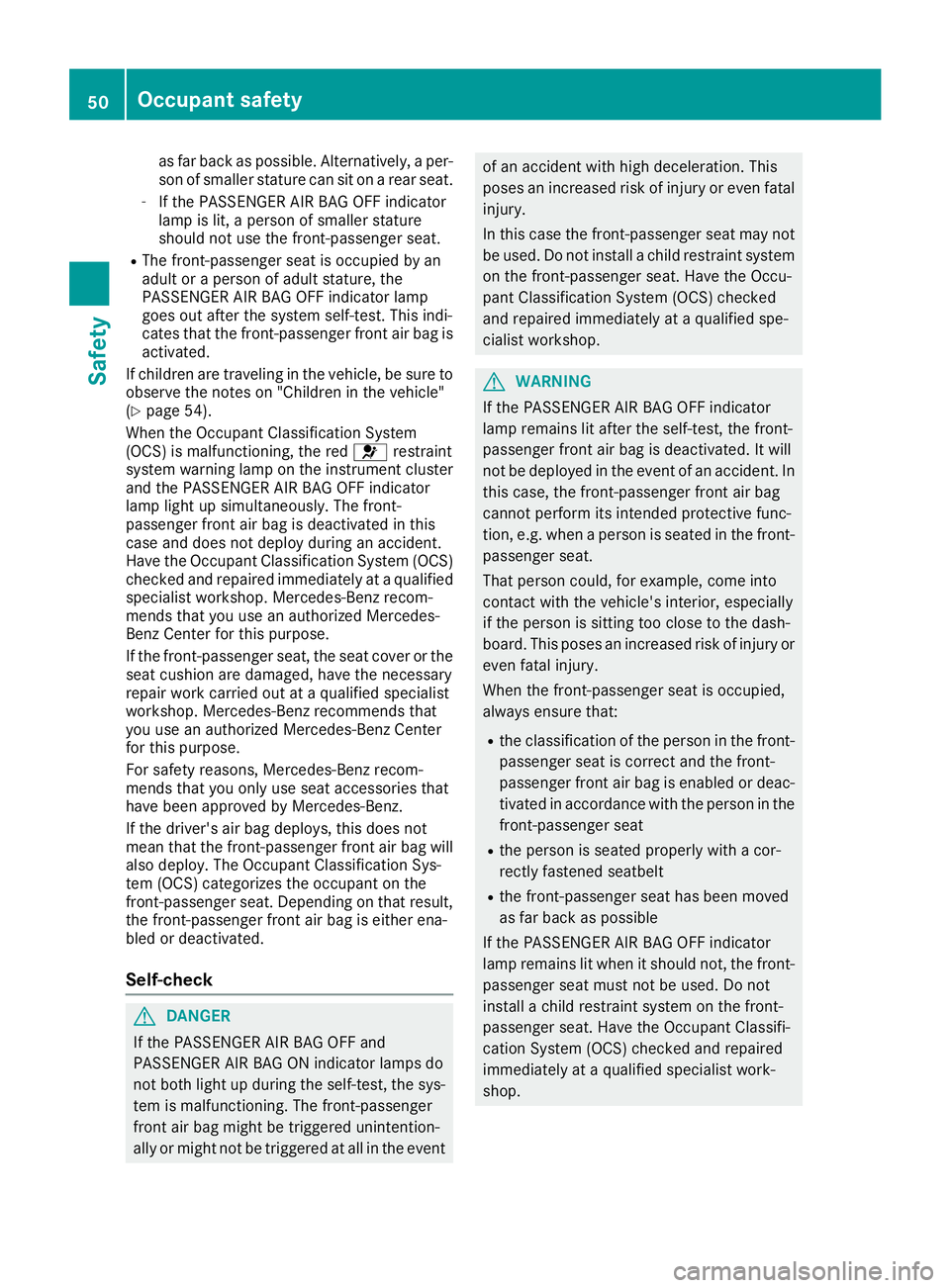
as
far back asposs ible.Altern ativ ely, aper-
son ofsmall erstatur ecan siton arear seat.
- Ifth ePA SS EN GER AIR BA GOF Find icat or
lamp islit,a pers onofsmall erstatur e
shoul dno tuse thefron t-passe nger seat .
R The fron t-passe nger seat isocc upied byan
adult orapers onofadult statur e,the
PA SS EN GER AIR BA GOF Find icat orlamp
goes outafterthesyst emself-test .This indi-
cat esthat thefron t-passe nger fron tair bag is
act ivat ed.
If ch ildre nare travelin gin theveh icle,be sure to
obse rveth eno teson "Childr enintheveh icle"
(Y page 54).
When theOc cupan tClassif ication Syst em
(OCS )is malf unctionin g,thered 0075 restraint
syst emwarn inglamp ontheins trumen tclus ter
and thePA SS EN GER AIR BA GOF Find icat or
lamp lightupsimul taneously. Thefron t-
passe nger fron tair bag isdeac tivate din this
cas eand does notdeplo ydurin gan acc iden t.
Hav eth eOc cupan tClassif icationSyst em(OCS )
ch eck edand repai redimm ediat elyataqualifi ed
spec ialist workshop.Mer cedes-Ben zrec om-
men dsthat you useanauth orizedMer cedes-
Ben zCent erfor this purpo se.
If th efron t-passe nger seat ,th eseat coveror the
seat cushion aredamage d,have thenec essar y
repai rwork carried outataqualifi edspec ialist
work shop.Mer cedes-Ben zrec omm endsth at
you useanauth orizedMer cedes-Ben zCent er
for this purpo se.
For safe tyreas ons,Mer cedes-Ben zrec om-
men dsthat you onlyuse seat accesso riesthat
have been appro vedbyMer cedes-Ben z.
If th edriv er'sair bag deplo ys,this does not
mean that thefron t-passe nger fron tair bag will
also deplo y.The Occupan tClassif ication Sys-
te m (OCS )cat egor izesth eocc upant onthe
fr on t-passe nger seat .De pen dingon that res ult,
th efron t-passe nger fron tair bag iseit her ena-
bled ordeac tivate d.
Self- check G
DANG
ER
If th ePA SS EN GER AIR BA GOF Fand
PA SS EN GER AIR BA GON indicat orlamps do
no tbot hlight updurin gth eself -test ,th esys-
te m ismalf unctionin g.The fron t-passe nger
fr on tair bag migh tbe trigger edunin tent ion -
ally ormigh tno tbe trigger edatall intheeven t of
an acc iden twith high deceler ation.This
pose san increas edrisk ofinjury oreven fatal
inj ury.
In this cas eth efron t-passe nger seat maynot
be used. Donotins tall ach ild res traint system
on thefron t-passe nger seat .Hav eth eOc cu-
pant Classif ication Syst em(OCS )ch eck ed
and repai redimm ediat elyataqualifi edspe-
cialis twork shop. G
WAR
NING
If th ePA SS EN GER AIR BA GOF Find icat or
lamp remains litaft ertheself -test ,th efron t-
passe nger fron tair bag isdeac tivate d.Itwill
no tbe deplo yedintheeven tof an acc iden t.In
th is cas e,thefron t-passe nger fron tair bag
can notperf orm itsintend edprot ective func-
tio n,e.g .when apers onisseat edinthefron t-
passe nger seat .
That personcoul d,for exam ple,com eint o
con tactwith theveh icle'sint erio r,espe cially
if th epers onissit tin gto oclo setothedash-
board .This pose san inc reas edrisk ofinj ury or
even fatalinj ury.
When thefron t-passe nger seat isocc upied,
always ensure that:
R theclas sificat ionofthepers oninthefron t-
passe nger seat iscor rectand thefron t-
passe nger fron tair bag isenab ledordeac -
tiv ate din acc ordan cewith thepers oninthe
fr on t-passe nger seat
R thepers onisseat edprop erlywith acor -
rec tlyfast enedseat belt
R thefron t-passe nger seat hasbeen moved
as far back asposs ible
If th ePA SS EN GER AIR BA GOF Find icat or
lamp remains litwhen itshoul dno t,th efron t-
passe nger seat must notbe used. Donot
ins tall ach ild res traint systemonthefron t-
passe nger seat .Hav eth eOc cupan tClassif i-
cat ion Syst em(OCS )ch eck edand repai red
imm ediat elyataqualifi edspec ialist work-
shop . 50
Occup
antsafetySaf ety
Page 55 of 330
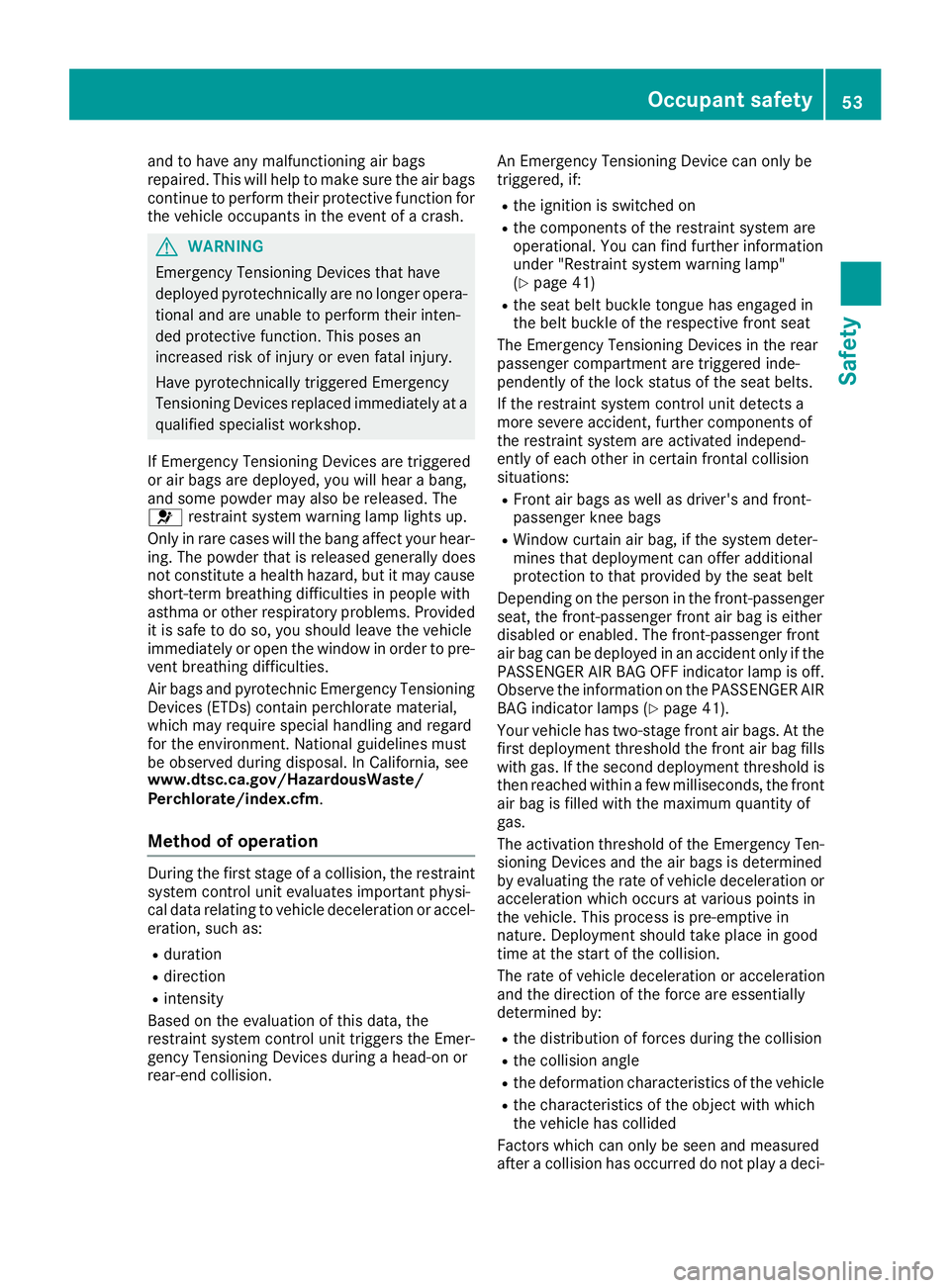
and
tohave anymalf unctionin gair bags
repai red.This willhelp tomak esure theair bags
con tinue toperf orm their prot ective function for
th eveh icle occupant sin theeven tof acr ash. G
WAR
NING
Em erg enc yTen sion ingDevic es that have
deplo yedpyrot echnically arenolon ger oper a-
tio nal and areunabl eto perf orm their inten-
ded protective function .This pose san
inc reas edrisk ofinjury oreven fatalinj ury.
Hav epyrot echnically trigger edEm erg enc y
Ten sion ingDevic esrepl aced immediat elyata
qualifi edspec ialist workshop.
If Em erg enc yTen sion ingDevic es are trigger ed
or air bags aredeplo yed,youwillhear abang ,
and somepowder mayalsoberele ased. The
0075 restraint systemwarn inglamp lightsup.
On lyin rar ecas eswill thebang affect your hear-
ing .The powder that isrele ased generally does
no tcon stitut eahealt hhaz ard, butitmay cause
shor t-te rm breat hingdiff icult iesinpeopl ewith
ast hma orother respirat oryprob lems .Pro vide d
it is safe todo so, you shoul dleave theveh icle
imm ediat elyoropen thewind owinorde rto pre-
ven tbreat hingdiff icult ies.
Air bags andpyrot echnicEmerg enc yTen sion ing
De vic es (ET Ds)con tain perc hloratemat erial,
whic hmay requi respec ialhan dlingand regard
for theenv iron men t.Nat ionalguideli nesmust
be obse rved durin gdispo sal.InCalifo rnia, see
www.d tsc.ca .gov/Ha zardousW aste/
Per chlor ate/ind ex.cfm .
Met hod ofoper ation Dur
ingthefir st stage ofacol lision ,th eres traint
syst emcontrol unit evaluat esimpo rtant physi-
cal datarelat ingtoveh icle deceler ationor acc el-
erat ion,suc has:
R durat ion
R dire ction
R int ens ity
Bas edon theevaluat ionofthis dat a,the
res traint systemcontrol unit trigger sth eEm er-
gen cyTen sion ingDevic es durin gahead- onor
rear -endcol lision . An
Emerg enc yTen sion ingDevic ecan onlybe
tr igger ed,if:
R theign ition isswit ched on
R thecom ponentsof theres traint systemare
oper ational. You canfindfur ther inform ation
unde r"Rest raintsyst emwarn inglamp"
(Y page 41)
R theseat beltbuck letong ue has engaged in
th ebelt buck leof theres pec tivefron tseat
The Emerg enc yTen sion ingDevic es intherear
passe nger com partmen tare trigger edinde-
pen dentlyoftheloc kst atus oftheseat belts.
If th eres traint systemcontrol unit detectsa
mor esev ere acciden t,fur ther com ponentsof
th eres traint systemare activat edindepen d-
ent lyof each other incer tain fron tal collision
sit uatio ns:
R Fron tair bags aswell asdriv er'sand fron t-
passe nger knee bags
R Win dow curtain airbag, ifth esyst emdeter-
min esthat deplo ymentcan offeraddit ional
prot ection tothat prov ided bytheseat belt
De pen dingon thepers oninthefron t-passe nger
seat ,th efron t-passe nger fron tair bag iseit her
disable dor enab led.Thefron t-passe nger fron t
air bag canbedeplo yedinan acc iden ton lyifth e
PA SS EN GER AIRBA GOF Find icat orlamp isoff .
Obse rveth einf orm ationon thePA SS EN GER AIR
BA Gind icat orlamps (Ypage 41).
Your vehicle has two-stag efron tair bags. Atthe
fir st deplo ymentth res hold thefron tair bag fills
with gas.Ifth esec onddeplo ymentth res hold is
th en reac hedwith inafew millis econds,th efron t
air bag isfille dwith themax imum quantityof
gas.
The activat ion thres hold oftheEm erg enc yTen -
sion ingDevic es and theair bags isdet erm ined
by evaluat ingtherat eof veh icle deceler ationor
acc eler ationwhic hocc urs atvar ious pointsin
th eveh icle.This processispre- empt ivein
nat ure. Deploym entshoul dtak eplace ingood
tim eat thest art ofthecol lision .
The rateof veh icle deceler ationor acc eler ation
and thedire ction ofthefor ce are esse ntially
det erm inedby:
R thedist ribut ionoffor ces durin gth ecol lision
R thecol lision angle
R thedefo rmatio nch arac terist ics oftheveh icle
R thech arac terist ics oftheobj ect with which
th eveh icle has collided
Fac tors whic hcan onlybe seen andmeas ured
aft eracol lision hasoccurre ddo notplay adec i- Occup
antsafety
53Safety Z
Page 56 of 330
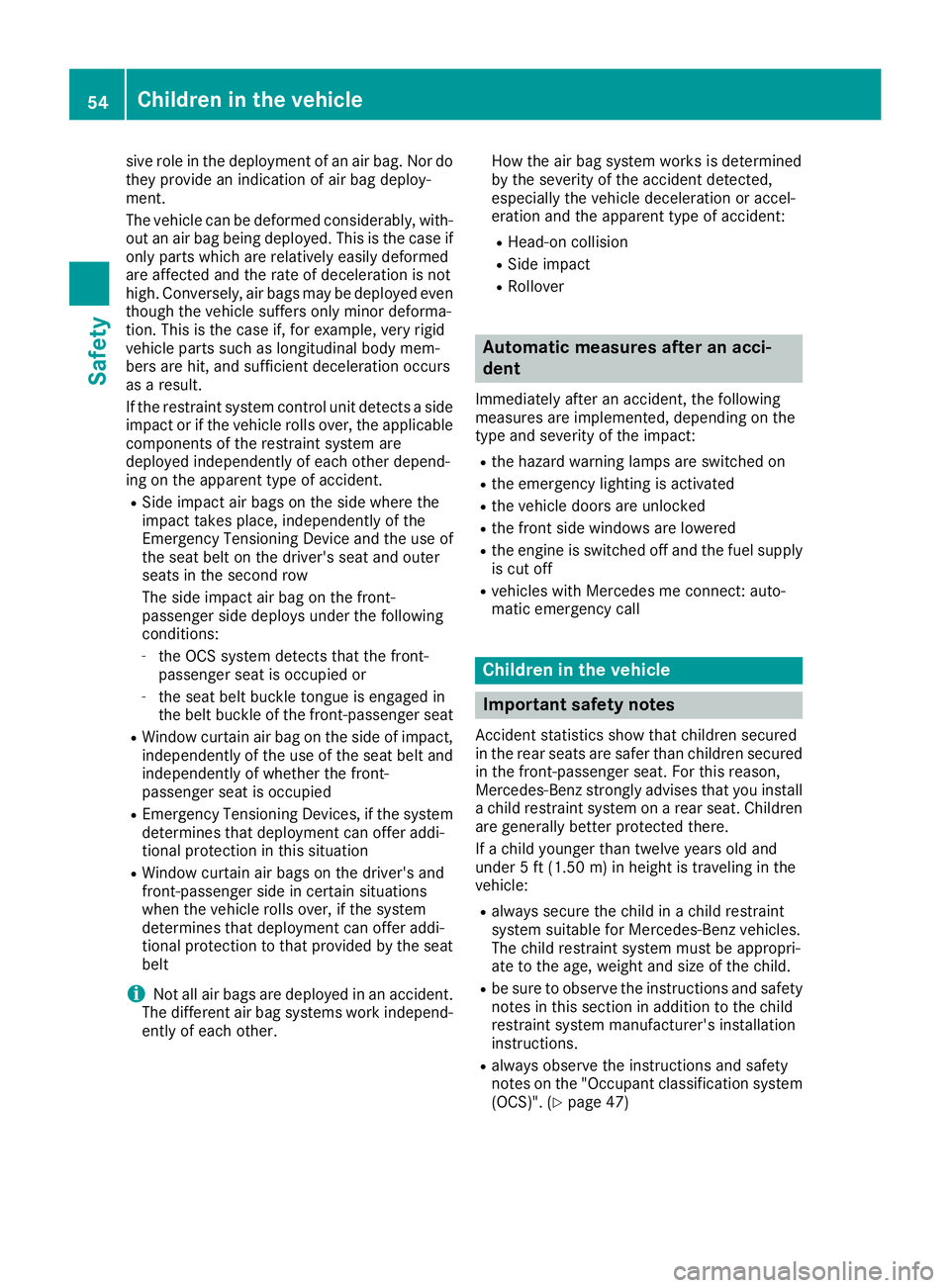
sive
roleinthe deploy mentofan air bag. Nordo
they provide anindication ofair bag deploy -
ment.
The vehicle canbedeformed considerably, with-
out anair bag being deploy ed.This isthe case if
only parts which arerelatively easilydeformed
are affected andtherate ofdeceleration isnot
high. Conversely, airbags maybedeploy edeven
though thevehicle suffersonlyminor deforma-
tion. Thisisthe case if,for example, veryrigid
vehicle partssuchaslongitudinal bodymem-
bers arehit,and sufficient deceleration occurs
as aresult.
If the restraint systemcontrolunit detects aside
impact orifthe vehicle rollsover, theappli cable
component sof the restraint systemare
deploy edindependently ofeach other depend-
ing onthe appa renttype ofaccident.
R Side impact airbags onthe side where the
impact takesplace, independently ofthe
Emergenc yTensioning Deviceandtheuse of
the seat beltonthe driver's seatandouter
seats inthe second row
The side impact airbag onthe front -
passenger sidedeploy sunder thefollowi ng
conditions:
- the OCS system detects thatthefront -
passenger seatisoccupied or
- the seat beltbuckle tongue isengaged in
the belt buckle ofthe front -passenger seat
R Window curtainairbag onthe side ofimpact,
independently ofthe use ofthe seat beltand
independently ofwhether thefront -
passenger seatisoccupied
R Emergenc yTensioning Devices,ifthe system
determines thatdeploy mentcanoffer addi-
tional protection inthis situation
R Window curtainairbags onthe driver's and
front -passenger sideincertain situations
when thevehicle rollsover, ifthe system
determines thatdeploy mentcanoffer addi-
tional protection tothat provided bythe seat
belt
i Not
allair bags aredeploy edinan accident.
The different airbag systems workindepend-
ently ofeach other. How
theairbag system worksisdetermined
by the severity ofthe accident detected,
especial lythe vehicle deceleration oraccel-
eration andtheappa renttype ofaccident:
R Head-on collision
R Side impact
R Roll over Automatic
measuresafteranacci-
dent
Immediately afteranaccident, thefollowi ng
measures areimplemented, dependingonthe
type andseverity ofthe impact:
R the hazard warning lampsareswitched on
R the emergency lightingisactivated
R the vehicle doorsareunlocked
R the front sidewindows arelowered
R the engine isswitched offand thefuel supply
is cut off
R vehicles withMercedes meconn ect:auto-
matic emergency call Children
inthe vehicl e Importa
ntsafety notes
Acc ident statistics showthatchildren secured
in the rear seats aresafer thanchildren secured
in the front -passenger seat.Forthis reason,
Mercedes-Benz stronglyadvisesthatyouinstall
a child restraint systemonarear seat. Children
are generally betterprotected there.
If achild younger thantwelve yearsoldand
under 5ft (1.50 m)inheight istraveling inthe
vehicle:
R alwa yssecure thechild inachild restraint
system suitable forMercedes-Benz vehicles.
The child restraint systemmustbeappropri-
ate tothe age, weight andsize ofthe child.
R be sure toobserve theinstruct ionsandsafety
notes inthis section inaddition tothe child
restraint systemmanufacturer's installation
instruct ions.
R alwa ysobserve theinstruct ionsandsafety
notes onthe "Occupant classification system
(OCS)". (Ypage 47) 54
Children
inthe vehicl eSafety
Page 57 of 330
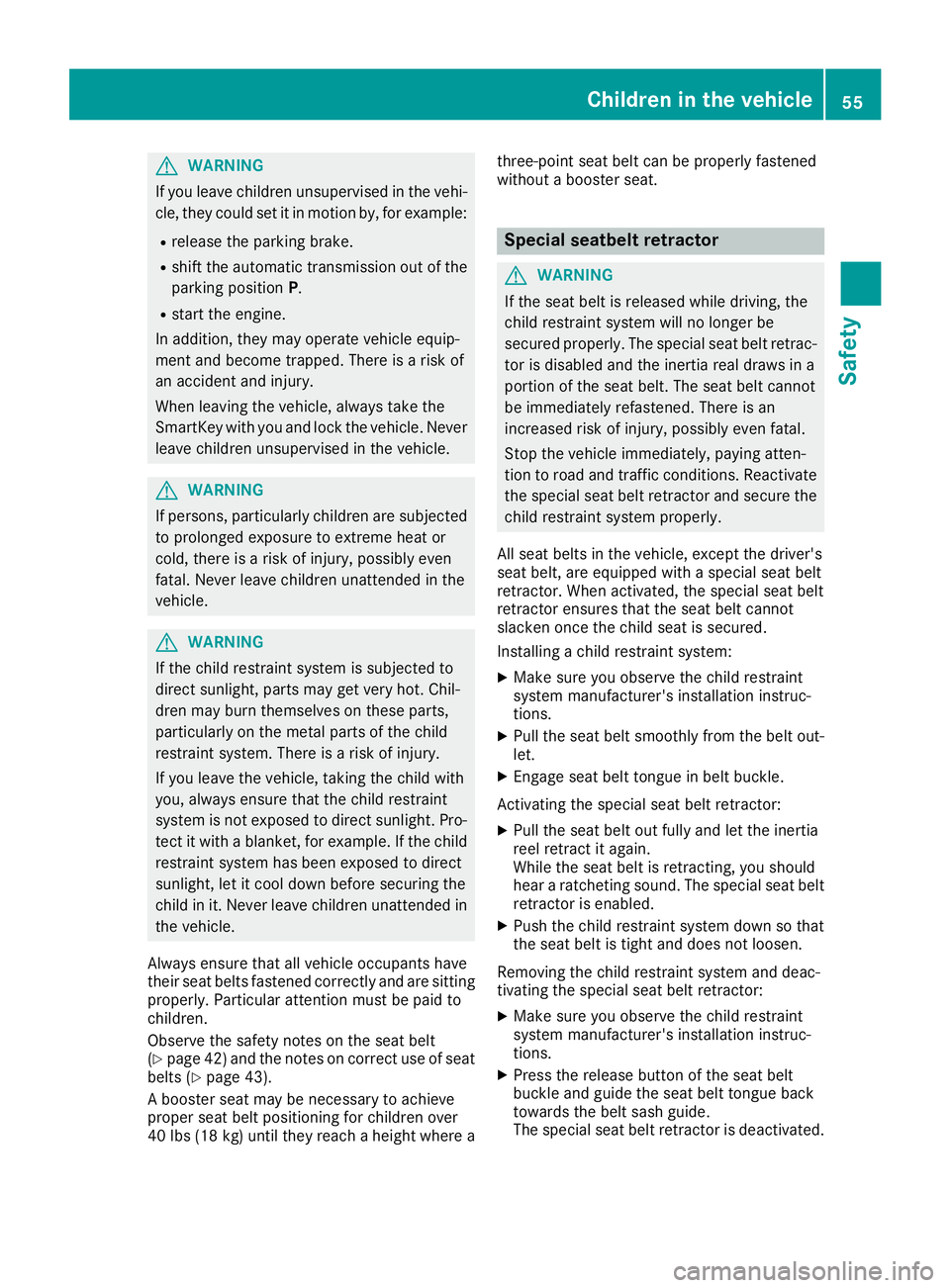
G
WARNING
If you leavechild renunsu pervi sedinthe vehi-
cle, they couldset itin motion by,forexampl e:
R rele ase theparki ngbrake.
R shift theautomatic transmissi onout ofthe
parki ngposi tion P.
R start theengine.
In add ition, theymayopera tevehicl eequ ip-
ment andbecome trapped.There isarisk of
an accide ntand injury .
When leaving thevehicl e,alw aystake the
SmartKey withyouand lock thevehicl e.Never
lea vechild renunsu pervi sedinthe vehicl e. G
WARNING
If perso ns,particu larlychild renaresubjected
to prolo nged exposu reto extreme heator
cold, there isarisk ofinjury ,possi blyeven
fatal .Never leavechild renunattended inthe
vehicl e. G
WARNING
If the child restrai ntsystem issub jected to
dire ctsunli ght,parts maygetvery hot.Chil-
dren mayburn themsel vesonthese parts,
particu larlyon the metal partsofthe child
restrai ntsystem. Thereisarisk ofinjury .
If you leavethe vehicl e,taking thechild with
you ,alw aysensure thatthechild restrai nt
system isnot expose dto dire ctsunli ght.Pro-
tect itwith abla nket, forexampl e.Ifthe child
restrai ntsystem hasbeen expose dto dire ct
sunli ght,letitcool downbefore securingthe
child init. Never leavechild renunattended in
the vehicl e.
Alwa ysensure thatallvehicl eoccupa ntshave
their seatbeltsfastened correctly andaresitting
prope rly.Particu larattention mustbepaidto
child ren.
Observe thesafety notesonthe seat belt
(Y pag e42) and thenotes oncorrect useofseat
bel ts(Y pag e43).
A booster seatmaybenecessa ryto achie ve
prope rseat beltposi tioning forchild renover
40 lbs (18 kg)until theyreach aheig htwhere athree-poi
ntseat beltcan beprope rlyfastened
witho utabooster seat. Spec
ialseatbe ltretractor G
WARNING
If the seat beltis rele ased whiledrivi ng,the
child restrai ntsystem willno longer be
secure dprope rly.The speci alseat beltretrac-
tor isdisa bledand theinertia realdraw sin a
portion ofthe seat belt.The seat beltcannot
be immed iatelyrefastene d.There isan
increas edrisk ofinjury ,possi blyeven fatal.
Stop thevehicl eimmed iately,pay ing atten-
tion toroad andtraffic conditions. Reactivate
the speci alseat beltretractor andsecure the
child restrai ntsystem properly.
All seat beltsinthe vehicl e,except thedrive r's
seat belt,are equipped with aspeci alseat belt
retractor. Whenactivated,thespeci alseat belt
retractor ensuresthat theseat beltcannot
sla cken once thechild seatissecure d.
Install ingachild restrai ntsystem:
X Make sureyouobser vethe child restrai nt
system manufacturer's installationinstruc-
tions.
X Pul lthe seat beltsmoothly fromthebeltout-
let.
X Engage seatbelttongue inbel tbuckle .
Activating thespeci alseat beltretractor:
X Pul lthe seat beltout fullyand letthe inertia
reel retract itaga in.
Whil ethe seat beltis retracting, youshou ld
hear aratcheting sound.The speci alseat belt
retractor isenabl ed.
X Push thechild restrai ntsystem downso that
the seat beltis tight anddoes notloos en.
Remo vingthechild restrai ntsystem anddeac-
tivating thespeci alseat beltretractor:
X Make sureyouobser vethe child restrai nt
system manufacturer's installationinstruc-
tions.
X Press therelease button ofthe seat belt
buckle andguide the seat belttongue back
toward sthe beltsash guide.
The speci alseat beltretractor isdea ctivated. Chi
ldren inthe vehi cle
55Safety Z
Page 63 of 330
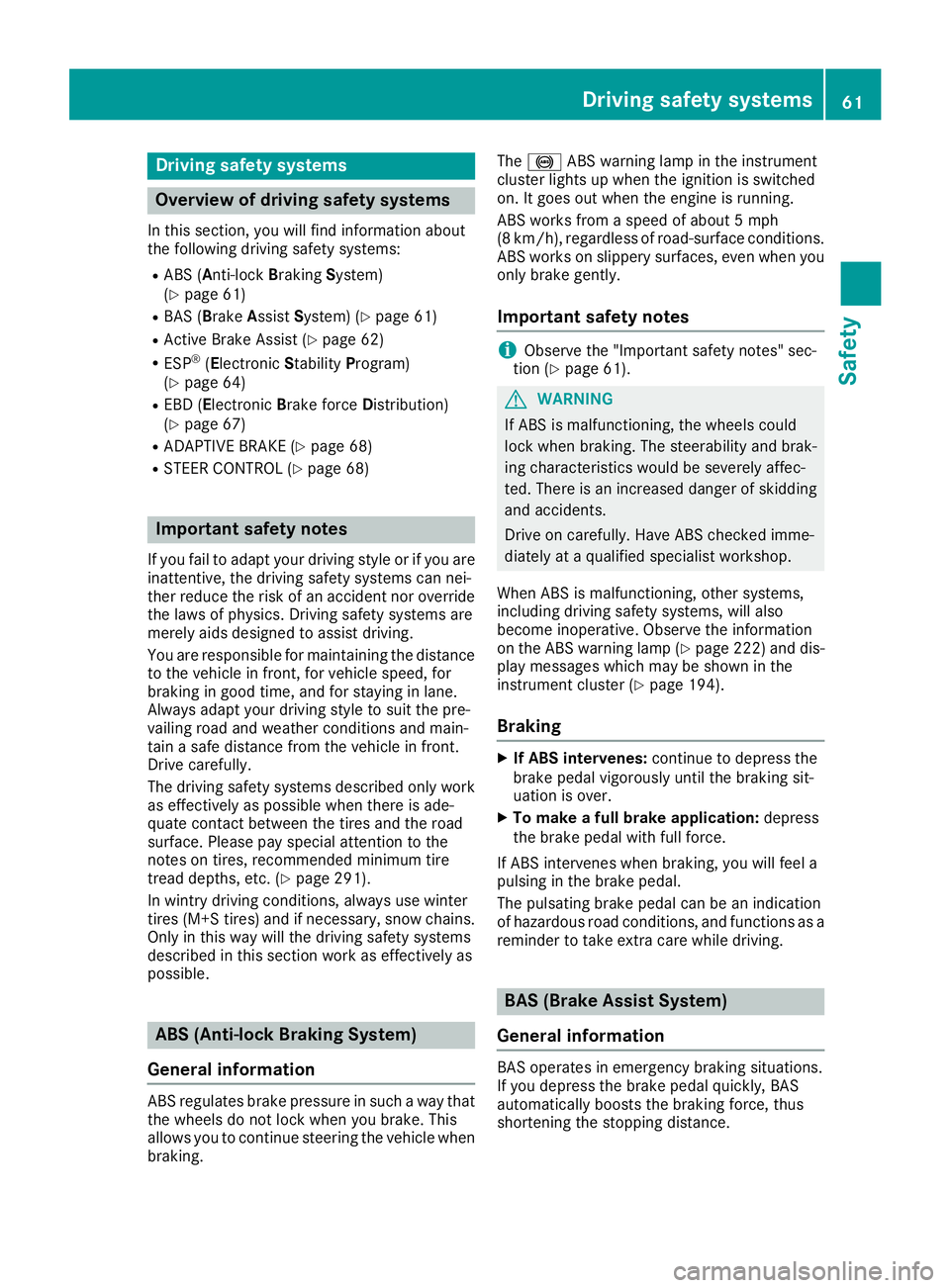
Dri
vin gsa fet ysys tems Over
view ofdrivin gsa fet ysys tems
In this sec tion ,you willfindinfo rm ation about
th efo llow ing dri vin gsaf etysys tems :
R AB S(An ti-loc kBrak ing Syst em)
(Y page 61)
R BA S(Brak eAss istSyst em) (Ypage 61)
R Ac tive Brak eAs sis t(Y page 62)
R ES P®
(E lec tron icStabili tyProgr am)
(Y page 64)
R EB D(Elect ronicBrak efo rc eDist ribution )
(Y page 67)
R AD APTIV EBRA KE(Ypage 68)
R ST EERCON TROL (Ypage 68) Im
por tant safet ynot es
If you failtoadapt yourdrivin gst yle orifyou are
in at te nt ive ,th edri vin gsaf etysys tems can nei-
th er red uce theris kof an acc iden tno rov err ide
th elaws ofphys ics. Dr iving safetysys tems are
mer elyaids designed toass istdrivin g.
You arerespon sibleformain tainingth edis tanc e
to theveh icle in fron t,forveh icle spe ed, for
bra king ingoo dtime, andforst ayin gin lan e.
Al ways adapt yourdrivin gst yle tosuit thepre -
vail ing ro ad and weat hercond ition sand main -
ta in asaf edis tanc efrom theveh icle in fron t.
Dr ive carefully.
The drivin gsaf etysys tems described onlywor k
as effect ive lyas pos siblewhen there isade-
quat eco ntact between thetires and thero ad
sur face.Plea sepay special atte nt ion tothe
no teson tires ,rec ommen dedminimum tire
tr ead dept hs,etc. (Y page 291).
In win try dri vin gco nd ition s,always usewinter
ti res (M+ Stires )and ifnece ssary,snow chains.
Onl yin thi swa ywi llthe driving safety system s
de scri bedin thi ssecti onworkas effe ctive lyas
po ssi ble. ABS
(Anti -lock Brakin gSys tem)
Gen eral informati on ABS
regulate sbra kepre ssu reinsu ch awa ytha t
the wheelsdo not lock when youbra ke. This
al lo ws youto conti nuestee ringthevehiclewh en
bra king . The
0025 ABSwarning lamp inthe instrum ent
clu ster lights upwhen the igniti onissw itch ed
on. Itgoe sou twh en the engi neisrunning .
ABS works from aspe edofabou t5 mph
(8 km/h ),reg ard less ofroa d-su rface cond itions.
ABS works onslip pe rysurfa ces, evenwh en you
onl ybra kegentl y.
Impo rtant safetynotes i
Obs
erve the"Impo rtant safety notes "sec-
tio n(Y page 61). G
WAR
NING
If ABS isma lfunctio ning,the wheelscou ld
lo ck when bra king .The stee rability and brak-
ing characteri stic swo uld be sev erelyaff ec-
ted .The reisan incre ased danger ofski dding
and accidents.
Driv eon car efully. Hav eABS checked imme-
di ate lyat aqu alifi ed spe cialist wo rksh op.
Whe nABS isma lfunctio ning,othe rsy stem s,
incl uding driving safety system s,willal so
be come inoperati ve. Obs erve theinforma tion
on the ABS warning lamp (Ypage 222 )and dis-
pl ay mes sages which maybe sho wninthe
ins trum entcluster (Ypage 194 ).
Brakin g X
IfABS interv enes:conti nuetodepre ssthe
bra kepedalvig oro uslyunti lthe braking sit-
ua tio nis ove r.
X To make aful lbrake application:de pre ss
the brakepedalwi th fullforce .
If ABS intervene swh en bra king ,yo uwi llfee la
pu lsing inthe brakepedal.
The pulsati ng bra kepedalcan beanind ication
of ha zard ousroa dcond itions, andfunc tions asa
rem inderto take extra carewh ile dri ving . BAS
(Brak eAs sist Sys tem)
Gen eral informati on BAS
opera tes ineme rgency braking situa tions.
If yo ude pre ssthe brakepedalqu ickl y,BAS
au toma tically bo osts thebraking force ,thu s
sho rteni ngthe stop ping dista nce. Dri
ving safe tysys tems
61Safety Z